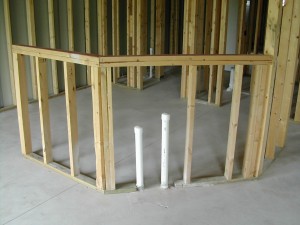We’ve been walking you through our finished basement project. In this post we will discuss our quality checklist for the mechanical rough-ins. Since we are adding a theater/rec room for our finished space, we don’t have any plumbing to inspect. If you have these in your new basement design, now would be the time to review those as well.
Rough Electrical: Check all wiring is in conduit if required by code. This helps protect the wires when you are hanging pictures or remodeling. Check all switch, outlet and light box locations. Be sure to verify not only the locations and quantity, but also the height and orientations. This is particularly important for the outlet and cable at your TV location. We want to avoid having wires dangling around these. Verify that the new circuits your electrician added are labeled. Finally, make sure your cable is tied into the splitter at the main cable entrance to the home. Also review any low voltage or speaker wires that have been run to make sure they are in the proper location.
Rough HVAC: Check all heat runs and supplies are installed per plan. Verify the sizes are correct. We also want to check to make sure all joints in the ductwork are sealed with either a mastic or a butyl tape. Make sure they didn’t use duct tape…it is notorious for falling off over time. The ironic thing about most duct tape…it’s good for everything but ducts! If you haven’t already, you will want to have your HVAC contractor review the sizing of your equipment (furnace and air conditioner) to make sure they can adequately heat and cool the new space. Most home systems are over-engineered so adding some basement space will typically be ok…especially after sealing up leaky ducts and adding basement insulation.
Rough Plumbing: One quick note on your plumbing quality check. It’s a good idea to run a pressure test on your new system to make sure everything is tight at this stage. With a pressure test, the plumber puts a certain amount of pressure in the supply lines and then places a gauge at one of the openings to make sure it stays consistent over a period of time. The supplies are tested with air and the drains typically with water. Once the drywall goes up, repairs will be tough to make…and I hate to see a brand new wall cut open to make a repair that could have been avoided!
This rough mechanical quality check is essential to building a quality project. Once the drywall goes up, it will be very difficult to get to these without major damage and re-work.


